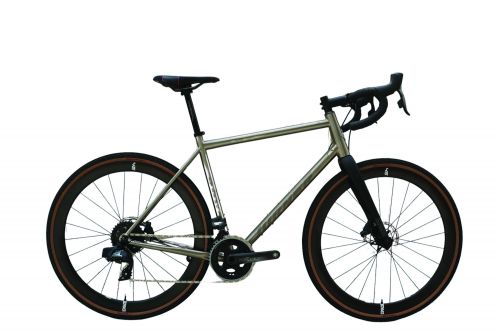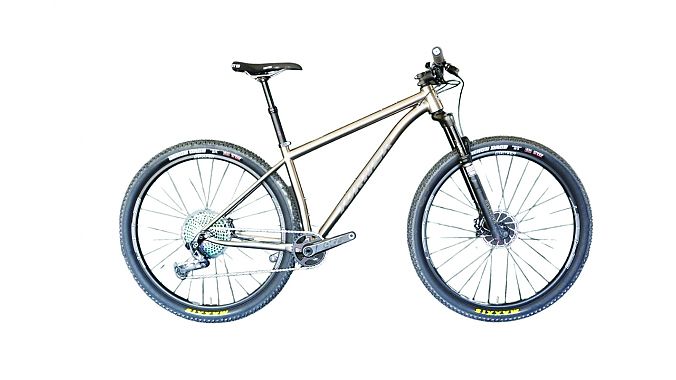A version of this article ran in the March issue of BRAIN.
MURRIETA, Calif. (BRAIN) — After “chasing the carbon dream” the past decade, Dave Turner said it’s time to return to his cycling roots. That means turning to titanium frame production and away — at least temporarily — from full-suspension production.
The boss of Turner Bikes began racing titanium mountain bikes in 1987 and never forgot the comfort that the material provides the rider. “Ti and steel are the kings of trail feel,” Turner said. “But the lighter weight, incredible long life, corrosion resistance, impact resistance, and a quiet feel puts ti at the top of my list.”
This pivot led to manufacturing titanium frames with hardtail (Nitrous), gravel (Cyclosys), and all-road (Arti) designs. A second hardtail design is on tap for the fall. It’s a big move by the small niche brand that until this year never made a hardtail and has built a loyal following for its full-suspension designs.
“There are many past and current Turner Bikes customers that are buying gravel bikes to supplement their mountain bikes,” Turner said. “Gravel bikes are fun and offer a new way to experience riding. The Nitrous hardtail is appealing to those that don’t need the big squish all the time, but they are not open to converting to a drop bar for less aggressive dirt they ride. … Few diehard riders have only one bike, so offering something different is actually proving to be popular. And for these riders, they are stoked. They know they will get a well-thought-out, great riding bike.”
During the company’s carbon decade, which followed using aluminum exclusively, Turner constantly played catchup with the evolving industry standard changes — from Boost spacing to longer, lower, slacker geometry — and that led to failed expectations, Turner said.
“Due to the rapid changes that the industry was creating, I was never on pace and the commercial success of the three carbon designs never met sales expectations,” he said. “For this new phase, I wanted to return to metal, where changes can be quickly implemented to meet yet another new standard, or where a change in geometry is just a matter of adjusting the miter and weld fixtures.
“With a carbon design, one has to look into the future a couple of years when creating a new model and accurately guess what will be in style. Miss the mark, and basically throw away six figures in tooling when the market shifts.”
Making the market shift required surveying past and current Turner Bikes riders and owners of competing titanium brands. The biggest potential hurdle that continually came up was the high cost. Turner investigated the possibility of using U.S. private label manufacturing.
“It quickly became apparent that there was no way to implement the list of standard features that I felt were needed and get the price of a frame where many riders could afford,” Turner said. “That meant keeping Turner Bikes production overseas.”
Turner would not identify the titanium factory in Asia, and he effusively praised it as being the best he’s worked with in 28 years.
“During the last year of COVID hysteria, they were two weeks late on a single production for Turner Bikes, and they informed me that they would be late a month in advance. No ‘two weeks, two weeks, two weeks.’ ... Anyone in this industry knows how rare accurate delivery dates are.”
Prices for the three models range from $2,495-$4,995 for complete bikes, depending on build. Turner Bikes, which in the past has had a dealer network, is exclusively direct-to-consumer now.
“Years ago, we had a robust stocking dealer network,” Turner said. “Over time, these evolved into dealers who would only sell our bikes, but didn’t want to stock. There were definitely a few exceptions, but these were far and few between. Not the greatest business model when we’re providing protected dealer territories, holding all the stock ourselves, and dealers weren’t even providing preseason projections or stocking a nominal amount of product.”
The website has been revamped, and the word on the new direction will be formally spread through the Turner email list. The new bikes will be on display this year at major mountain bike and gravel events, including Sea Otter in October, but could be subject to change depending on the state of the pandemic.
Fans of the former Turner Suspension Bikes family should not fret. Turner said he isn’t abandoning full-suspension.
“Of course, I still have my eye on full suspension, and as much as I love the current bikes, I still need a new suspension bike in my quiver,” he said. “Wheel size? Done. Travel? Narrowing it down. Geometry? Working it out. … I just have to figure out what I want and what I will make it out of, etc.”




